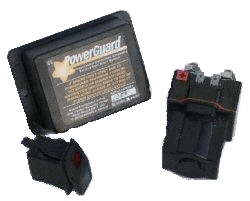Please note that this page is currently under reconstruction. The SmartGuard and PowerGuard have been completely redesigned into a new case. New details to follow shortly. The product shown on this page is no longer available. The replacement product, the "PowerGuard MKII" has even lower power consumption and extra features. Please contact us for further details.
SmartGuard.... "Protection for your engine start and auxiliary batteries"
It is a fact that a flat engine start battery can be a real problem. The inability to start an engine can be highly inconvenient, and in the case of commercial operations very expensive by the time the full costs are added up.
The inability to start an ocean or river going vessel's engine can be downright dangerous.
Overdischarged deep cycle batteries have their life severely shortened.
All these problems can be cured with the SmartGuard.
SmartGuard is a voltage sensitive Electronic Control Unit (ECU) forming the heart of an engine start or flat battery protection system. Additional equipment required is a manual reset switch/indicator (details in owners manual) and the high power latching relay available from SmartGauge Electronics.
SmartGuard is the standard unit as marketed by SmartGauge Electronics. PowerGuard is a marginally different version marketed by Merlin Equipment Ltd, one of our distributors
Available in 2 models. One designed to ensure the engine start battery retains sufficient power to start the engine. The other designed to ensure that a domestic or house battery bank is not continually discharged below a certain charge level. That level being that which it is accepted severely shortens the life of the batteries.
This level of charge is determined by a combination of the battery voltage, the ambient temperature and the time during which the voltage level remains low.
|
|
|
|
|
Protect your battery investement with the Battery protection model or ensure your fleet/hire boats will always start irrespective of what equipment is left on with the engine protection model. Absolutely ideal for fitment to hire boats or ocean going vessels where the inability to start the engine could be highly dangerous not to mention inconvenient. Both units feature the same circuitry which utilises ultra low power semiconductors and design techniques which results in a standby power drain that is at least 10 times lower than any comparable units we could find. The use of the latching relay (solenoid) means power is only used for a brief period during connection or disconnection of the relay. The standby power consumption (ie the power it will use all the time in normal circumstances) of SmartGuard is less than 200uA (0.0002 amps). To put that into some sort of perspective it amounts to less than 2Ah per year! This ensures that the addition of SmarGuard will in no way increase the level at which the batteries are being drained. A typical 100Ah deep cycle battery could power half a million of these units for an hour or 10 of them for almost 6 years! Specifications
Standy current <200uA (<0.0002 Amps) |
Page last updated 02/04/2008.
Website best viewed on a computer of some sort.

